 If you have been following the Coffee Spot for any length of time, you’ll know that I really, really dislike the way that coffee tastes when drunk from disposable cups. This led me to adopt a somewhat evangelical attitude to reusable coffee cups and, while I championed them for some time on the Coffee Spot, I began to realise that I was doing so in a rather haphazard fashion.
If you have been following the Coffee Spot for any length of time, you’ll know that I really, really dislike the way that coffee tastes when drunk from disposable cups. This led me to adopt a somewhat evangelical attitude to reusable coffee cups and, while I championed them for some time on the Coffee Spot, I began to realise that I was doing so in a rather haphazard fashion.
To counter that, and to bring everything together in one place, I launched this page, my Coffee Spot Guide to Reusable Cups, at the start of 2017. I also wrote a wider article on the subject of reusable cups to go with it, along with a follow-up in 2018. Since then, I’ve added new reusable cups as and when I get them.
The guide provides a short summary for each of the reusable coffee cups that I use, my thoughts on each one, plus links to the articles I’ve written about them. I’ve grouped them as follows in what I hope is a fairly logical manner:
- Glass cups (KeepCup, JOCO Cup, SoL Cup)
- Plastic cups (UPPERCUP, Smart Cup)
- Coffee waste (Kaffeeform, HuskeeCup)
- Ceramics (Therma Cup, Frank Green Ceramic)
- Other materials (Ecoffee Cup, Eco To Go Cup, Global WAKECup)
- Miscellaneous (Travel Press)
Please note that this page does not pretend to be a comprehensive guide to the reusable cups available in the marketplace. These are simply the cups which I own (all of which, with the exception of the Frank Green Ceramic, were given to me as gifts). I also have very specific requirements: for example, with the odd exception, I am not interested in anything with a capacity over 9 fl oz (about 250 ml), nor am I that bothered if the cup keeps my drink warm for long periods of time. Another example is lid design: I never drink coffee with the lid on, so I can’t tell you which particular opening is best for taste, etc.
Glass Cups
Glass cups are still, in my opinion, something of a benchmark, although they are slowly losing that exulted status. I like drinking coffee out of glass. I like the way it feels and tastes. One initial problem I had with glass was a fear that the cups would break too easily, but years of carrying them around in my rucksack and in coat pockets has proved this fear to be unfounded. The other, on-going issue with glass is that it doesn’t keep the drink warm.
For me, this is rarely a problem, since my flat white rarely lasts long enough to get cold. However, one issue I do have is that the cups can get very warm to the touch (even with the various sleeves designed to make them easy to hold. I’m aware of three makes of glass cup, all from Australia. For me, there’s not a lot to choose between the three, the choice largely coming down to aesthetics/ethics (and probably availability).
KeepCup
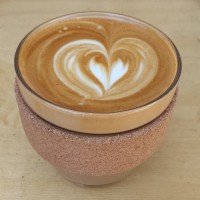 The Australian KeepCup is so successful that “KeepCup” has become synonymous with “reusable cup” in some circles. I’m only talking here about the 8 oz glass KeepCups. For me, they are still in many ways the benchmark cup. I’m now onto my third KeepCup (a gift from The Roasting Party). Although the KeepCup has proved durable, I broke both my previous ones. The first slipped while posing for a photo in Dublin and was dashed to pieces on unforgiving flagstones. The second met a similar fate on the tiles of my kitchen floor when it jumped out of my rucksack. These days, I keep a closer eye on my KeepCup!
The Australian KeepCup is so successful that “KeepCup” has become synonymous with “reusable cup” in some circles. I’m only talking here about the 8 oz glass KeepCups. For me, they are still in many ways the benchmark cup. I’m now onto my third KeepCup (a gift from The Roasting Party). Although the KeepCup has proved durable, I broke both my previous ones. The first slipped while posing for a photo in Dublin and was dashed to pieces on unforgiving flagstones. The second met a similar fate on the tiles of my kitchen floor when it jumped out of my rucksack. These days, I keep a closer eye on my KeepCup!
I wrote two major articles about the KeepCup:
JOCO Cup
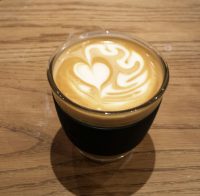 JOCO Cups is another Australian firm, but, unlike KeepCup, which has plastic versions, JOCO Cups only makes glass cups. Again, I’m looking here at the 8 oz version, although larger sizes are available. There are slight differences in look and feel, the main one being the lid, although I have no strong opinion either way. What I have found is that both my JOCO Cups (both gifts from the UK distributor) cracked during washing, one in a dishwasher, one while running under hot water. Currently I do not own a JOCO Cup.
JOCO Cups is another Australian firm, but, unlike KeepCup, which has plastic versions, JOCO Cups only makes glass cups. Again, I’m looking here at the 8 oz version, although larger sizes are available. There are slight differences in look and feel, the main one being the lid, although I have no strong opinion either way. What I have found is that both my JOCO Cups (both gifts from the UK distributor) cracked during washing, one in a dishwasher, one while running under hot water. Currently I do not own a JOCO Cup.
I wrote two major articles about the JOCO Cup:
SoL Cup
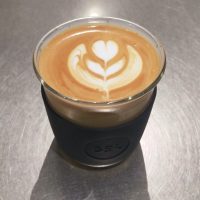 SoL Cups is yet another Australian product, which was launched in late 2016. Like JOCO Cups, the SoL Cup is only available in glass. As usual, I’ve only considered the 8 oz version, although it also comes as a 12 oz. One of the SoL Cup’s standout features is that each one is hand-blown. I don’t know if this is a consequence of the method of production or not, but the resulting cup is much thinner and lighter than either the JOCO Cup or KeepCup, so if you are worried about weight, this could be the cup for you. I was initially concerned that this might make it fragile, but after 2½ weeks of travelling around Japan with it, I’ve put those concerns to rest!
SoL Cups is yet another Australian product, which was launched in late 2016. Like JOCO Cups, the SoL Cup is only available in glass. As usual, I’ve only considered the 8 oz version, although it also comes as a 12 oz. One of the SoL Cup’s standout features is that each one is hand-blown. I don’t know if this is a consequence of the method of production or not, but the resulting cup is much thinner and lighter than either the JOCO Cup or KeepCup, so if you are worried about weight, this could be the cup for you. I was initially concerned that this might make it fragile, but after 2½ weeks of travelling around Japan with it, I’ve put those concerns to rest!
I wrote one major article about the SoL Cup:
Plastic Cups
I’ll confess, I’m not a huge fan of plastic cups. There’s something about the way that the coffee tastes from most plastic cups that puts me off. Plastic is not something that I want to drink coffee out of. The two cups listed here are exceptions to that rule, although I fear my inbuilt prejudice against plastic still makes me look down on them.
One major advantage of plastic over glass is that plastic is much more durable. I never had an issue with putting my plastic cups in a bag/pocket nor do I worry about dropping them. Another major advantage is that they have far better thermal insulation and hence are much cooler to the touch.
UPPERCUP
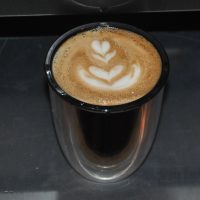 The UPPERCUP is another Australian product, a double-walled BPA-free plastic cup which was a gift from the UK distributor. It is light and durable, which won it a place on my coast-to-coast trip across the USA in 2015 and my around-the-world trip in 2016. However, for day-to-day use in the UK, it often losses out to my other cups. A major issue I have is with the lid, which although very secure once on, is so fiddly to put on that I rarely bother. It’s also extremely hard to photograph, although I guess that’s more a coffee blogger problem!
The UPPERCUP is another Australian product, a double-walled BPA-free plastic cup which was a gift from the UK distributor. It is light and durable, which won it a place on my coast-to-coast trip across the USA in 2015 and my around-the-world trip in 2016. However, for day-to-day use in the UK, it often losses out to my other cups. A major issue I have is with the lid, which although very secure once on, is so fiddly to put on that I rarely bother. It’s also extremely hard to photograph, although I guess that’s more a coffee blogger problem!
As well as reading about my travels with the UPPERCUP, I wrote one major article about it:
Smart Cup
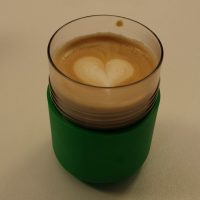 The Smart Cup, by Australian company Frank Green, is probably not the product for me. It’s a neat piece of design, effectively a plastic cylinder surrounded by thick insulation. It easily has the most secure lid, which screws on and which can be closed completely to stop spillage. However, I find it bulky and so when I’m looking for something light, it usually loses out to the UPPERCUP. It also has an in-built payment method, although this requires the payment terminals to be implemented which I don’t think has happened in the UK.
The Smart Cup, by Australian company Frank Green, is probably not the product for me. It’s a neat piece of design, effectively a plastic cylinder surrounded by thick insulation. It easily has the most secure lid, which screws on and which can be closed completely to stop spillage. However, I find it bulky and so when I’m looking for something light, it usually loses out to the UPPERCUP. It also has an in-built payment method, although this requires the payment terminals to be implemented which I don’t think has happened in the UK.
I wrote one major article about the Smart Cup:
When I first had a Smart Cup, it was the 12 oz version, which was way too big for me. Since then Frank Green provided me with the new, 8 oz version. Although this is smaller, it is still too bulky for me. However. if you want something that is effectively spill-proof, then this is hands down the cup for you! Frank Green also has a ceramic cup, which you’ll find listed separately.
Coffee Waste
These days, cups come in a variety of materials, one of which, when you’re a coffee drinker, really stands out: coffee waste! Cups made from coffee waste combine the best of both glass and plastic: they are a dream to drink out of, like glass, but with the durability and thermal properties of plastic.
I’m aware of two cups made from coffee waste, which come from opposite ends of the journey from coffee cherry to your daily cup of coffee. The first is made of recycled coffee grounds, left overs from the very end of the process. In contrast, the second uses coffee husk, a by-product of from the start of the journey, coffee processing (where you extract the coffee bean from the coffee cherry).
Kaffeeform Cup
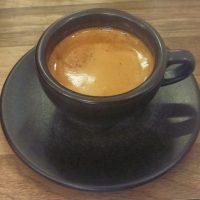 Technically, the Kaffeeform Cup, from Germany, is not a reusable cup in the sense that it is being marketed as a straight espresso cup, it’s unique claim to fame being that it is made from recycled coffee grounds. However, I use it as a reusable cup and have been carrying it around since the 2016 London Coffee Festival with no ill effect (I used to carry a china cup around with me, but that chipped far too easily). It’s also surprisingly light, which is something people invariably comment on when I hand it over.
Technically, the Kaffeeform Cup, from Germany, is not a reusable cup in the sense that it is being marketed as a straight espresso cup, it’s unique claim to fame being that it is made from recycled coffee grounds. However, I use it as a reusable cup and have been carrying it around since the 2016 London Coffee Festival with no ill effect (I used to carry a china cup around with me, but that chipped far too easily). It’s also surprisingly light, which is something people invariably comment on when I hand it over.
You might wonder why, since I have all these other cups, but the simple truth is that espresso tastes better out of an espresso cup, which is where the Kaffeeform Cup comes in. In an 8 oz cup, an espresso looks a little lost, but in my Kaffeeform Cup, it’s perfect.
I’ve only written once about my Kaffeeform Cup, which was an accidental gift from the manufacturer:
HuskeeCup
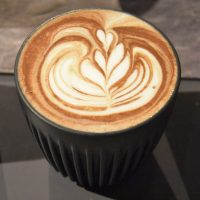 Like the Kaffeeform Cup, the HuskeeCup is just as much at home in the coffee shop as it is in my rucksack, although it is aimed firmly at both markets, coming with either a saucer (shop use) or a lid (takeway). Available in 6oz, 8oz and 12oz sizes, I naturally opted for the 6oz cup. Although an Australian product, it is distributed by Eco To Go in the UK. The HuskeeCup has an innovative ribbed design, with vertical fins running from the base to almost the lip of the cup. This gives the cup a striking, stylish look, and keeps it cool to the touch.
Like the Kaffeeform Cup, the HuskeeCup is just as much at home in the coffee shop as it is in my rucksack, although it is aimed firmly at both markets, coming with either a saucer (shop use) or a lid (takeway). Available in 6oz, 8oz and 12oz sizes, I naturally opted for the 6oz cup. Although an Australian product, it is distributed by Eco To Go in the UK. The HuskeeCup has an innovative ribbed design, with vertical fins running from the base to almost the lip of the cup. This gives the cup a striking, stylish look, and keeps it cool to the touch.
I’ve only written one article about the HuskeeCup:
Ceramic
Ceramics are, of course, traditional materials for cups of all sorts, but rarely associated with reusable cups. I have two cups in this category, the first a dual-walled ceramic cup, and the second a metal cup with a ceramic lining.
Therma Cup
 The Therma Cup, a gift from the designer Jody Leach, is one of my favourite cups which always seems to find its way on my trips. In contrast to what is an Australian-heavy list, the Therma Cup is designed and manufactured in the UK. It’s a beautiful, double-walled, thermally insulated 8 oz ceramic cup, which combines all the advantages of a glass cup with the thermal insulation of a plastic cup. Originally only available in white, since the end of 2017, the Therma Cup range has been extended to include yellow, grey and blue.
The Therma Cup, a gift from the designer Jody Leach, is one of my favourite cups which always seems to find its way on my trips. In contrast to what is an Australian-heavy list, the Therma Cup is designed and manufactured in the UK. It’s a beautiful, double-walled, thermally insulated 8 oz ceramic cup, which combines all the advantages of a glass cup with the thermal insulation of a plastic cup. Originally only available in white, since the end of 2017, the Therma Cup range has been extended to include yellow, grey and blue.
My main concern was, like the glass cups, its perceived fragility. However it’s been knocking around in my rucksack on and off since the middle of 2016, surviving multiple trips, including its first to Phoenix and the Grand Canyon, so I think it has proved its worth. Although wonderfully light, it is quite bulky, a legacy of its double-walled nature.
I’ve written about the Therma Cup on three different occasions:
- London Coffee Festival 2016
- Manchester Coffee Festival 2016
- Travels with my Coffee: Florida & Arizona, 2018
Frank Green Ceramic
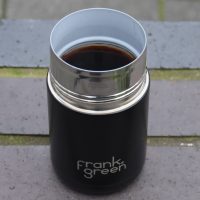 The original Frank Green reusable cup, the SmartCup, was an all-plastic affair. The latest additions to the range are made of stainless steel with a ceramic inner lining, but other than that, they have the same design and features of the original. Perhaps best of all, the lids between the two ranges are interchangeable (and available separately).
The original Frank Green reusable cup, the SmartCup, was an all-plastic affair. The latest additions to the range are made of stainless steel with a ceramic inner lining, but other than that, they have the same design and features of the original. Perhaps best of all, the lids between the two ranges are interchangeable (and available separately).
The two biggest advantages to the Frank Green range are that they are thermally insulated and that, with the lid closed, spill proof. The downside is that the cups are, for their capcity, bulky. Compared to the original SmartCup, the Frank Green ceramic is slightly bulkier and heavier, but is so much nicer to the touch and to drink out of.
I’ve written one article about the Frank Green Ceramic:
Other Materials
As well as coffee waste, cups come in a variety of other materials, including bamboo and rice husk!
Ecoffee Cup
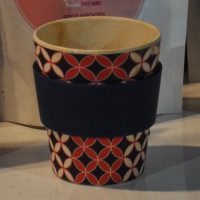 The Ecoffee Cup, which I first came across at the 2016 London Coffee Festival, is made from bamboo fibre and, like the Kaffeeform and Therma Cup, it’s surprisingly light. Originally, it only came in two sizes, 12oz & 14oz. However, a smaller, flat-white friendly 8oz cup came out in September 2016 and Ecoffee kindly sent me one. I took it on a month-long trip around the USA at the start of 2017 and was suitably impressed with its durability. Since then it has become a regular on longer trips, when I need something light and compact.
The Ecoffee Cup, which I first came across at the 2016 London Coffee Festival, is made from bamboo fibre and, like the Kaffeeform and Therma Cup, it’s surprisingly light. Originally, it only came in two sizes, 12oz & 14oz. However, a smaller, flat-white friendly 8oz cup came out in September 2016 and Ecoffee kindly sent me one. I took it on a month-long trip around the USA at the start of 2017 and was suitably impressed with its durability. Since then it has become a regular on longer trips, when I need something light and compact.
I wrote two articles about the Ecoffee Cup:
Eco To Go Cup
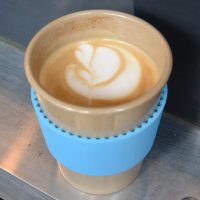 Another addition to my growing arsenal of reusable cups, the Eco To Go Cup is made from 80% rice husk, a waste product from rice production, and 20% plant resin. It’s also fully biodegradable, so if you do decide to throw it away, it doesn’t have to go into landfill.
Another addition to my growing arsenal of reusable cups, the Eco To Go Cup is made from 80% rice husk, a waste product from rice production, and 20% plant resin. It’s also fully biodegradable, so if you do decide to throw it away, it doesn’t have to go into landfill.
In look and feel, it’s very similar to the Ecoffee Cup, light and very durable. It comes in two sizes, 14oz and 9oz, with the manufacturers kindly sending me the smaller one to try out. I took it to the Glasgow Coffee Festival and on a day out to Lord’s and was very impressed. It’s now vying with the Ecoffee Cup as my main travel companion when I need something light and compact.
I’ve written about the Eco To Go Cup on two occasions.
Global WAKEcup
Global WAKEcup is another UK brand, part of a family of eco-friendly products. Technically this is the 9oz Travel Mug, a double-walled stainless steel mug with a bamboo outer sleeve and, unusually in the reusable cup market, a handle (also covered in bamboo). It’s an eye-catching little number, regularly drawing the most “oh wow!” comments from baristas. It’s also quite novel having a handle, although the wall of the mug is also cool to the touch, the mug doing an excellent job of keeping the contents warm. Being stainless steel, the mug doesn’t affect the taste and I really enjoy drinking out of it.
I’ve only written once about my Global WAKEcup:
Miscellaneous
This section covers things that technically aren’t reusable cups, but which definitely fall into the reusable/travel section.
Travel Press
 The Travel Press, from Canadian firm Espro, is a combined travel cup and coffee maker (so in that sense, I suppose it is a reusable cup, although I don’t use it as one). I was given one as gift at the World of Coffee in Dublin and, as is the case with several of the reusable cups I’ve discussed here, I was initially sceptical. However, within a week of owning it, I was a convert. I don’t use it as a cup, but I do use it to make my coffee (it acts like a cafetiere), which I then pour into a cup to drink.
The Travel Press, from Canadian firm Espro, is a combined travel cup and coffee maker (so in that sense, I suppose it is a reusable cup, although I don’t use it as one). I was given one as gift at the World of Coffee in Dublin and, as is the case with several of the reusable cups I’ve discussed here, I was initially sceptical. However, within a week of owning it, I was a convert. I don’t use it as a cup, but I do use it to make my coffee (it acts like a cafetiere), which I then pour into a cup to drink.
The key feature is that the Travel Press keeps the coffee warm for several hours and has a leak-proof lid, so I can make my coffee in the morning and then take it with me, for example, on planes, on hikes to the Grand Canyon and to business meetings where the coffee is terrible!
Other than my experience on planes, I’ve written one article about my Travel Press, although it also features extensively (along with many of my reusable cups in my Travels with my Coffee series):
For a different perspective, try European Coffee Trip’s guide to reusable cups.

